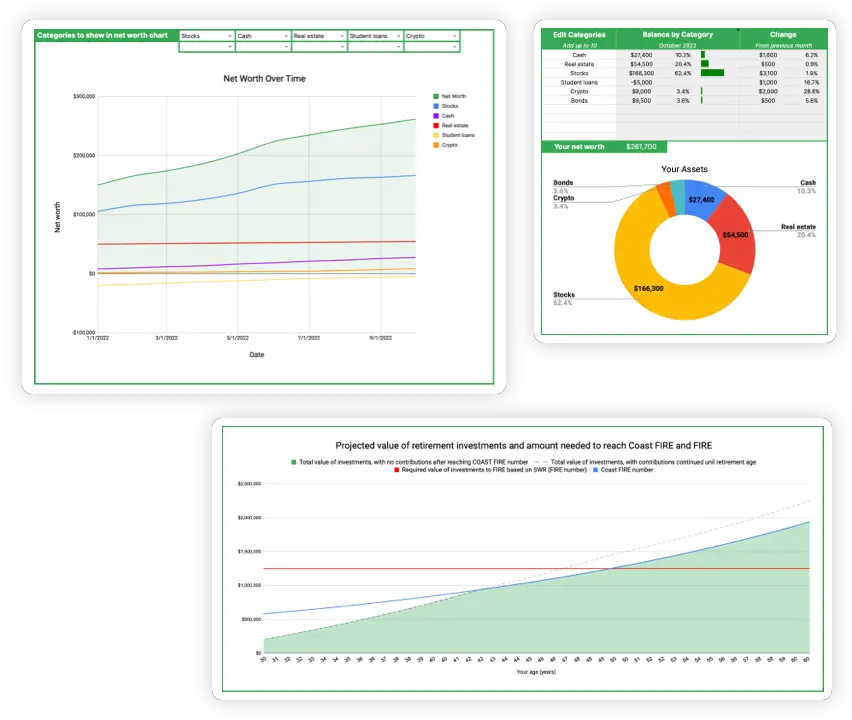Calculate how much of a salary raise you need to keep up with inflation
Take your wealth planning to the next level with my Wealth Planning Toolkit for Google Sheets – just $20.
Plan for recurring monthly income over different time periods as well as windfalls and one-time purchases in the future.
Includes 10 year Net Worth Tracker with Dashboard, Asset Rebalancing Calculator, and advanced FIRE and Coast FIRE Calculators.

Introduction
In recent years, we have seen dramatic increases in the cost of goods and service across the USA and the world, which is known as inflation. With the cost of everything from gas to housing rising rapidly, “keeping up with inflation” by earning more income is essential to build your wealth. But how much of an increase in income do you need to keep pace with inflation? Or better yet, maintain the same savings rate that you had before the record inflation we have seen over the past year? I made this calculator to help you find out.
This calculator was inspired by the article You’ve Been Thinking About Inflation All Wrong by Nick Maggiulli. Nick makes the point that keeping up with inflation is much more nuanced than simply getting a raise that is equal to the Consumer Price Index (CPI). If you are a heavy saver, then you need less of a raise to cover an increase in spending than a person who is living paycheck-to-paycheck, which makes sense.
However in his article, Nick neglected to consider the impact of income taxes on how much of a raise is required, as well as the idea of maintaining the same savings rate. So to expand on Nick’s concept, I built this calculator which adds some additional factors like marginal income tax rate and maintaining the same savings rate that you had initially.
Using this calculator
This interactive calculator makes it easy to calculate how much of a raise you need to keep up with inflation and how this could impact your savings rate. Simply input your numbers and the calculator will automatically update.
- Annual inflation rate is the annual inflation rate that you personally experience in your spending due to increases in cost of things like rent, food, and fuel costs.
- Marginal income tax rate is the rate of income tax that you pay on every additional dollar that you earn as income. You can check out Smart Asset’s Income Tax Calculator to determine your marginal income tax rate.
- Monthly take-home pay is your monthly take-home pay after paying all taxes, before you get a raise. This does include pre-tax contributions to things like a 401k or HSA.
- Monthly spending is your total monthly spending before you experience price increases due to inflation.
The calculator then breaks down results into two scenarios: 1) keeping up with inflation and 2) maintaining your initial savings rate. Keeping up with inflation calculates how much of a raise you need to save the same amount in absolute terms as you did before inflation, considering your marginal income tax on any raise you recieve. The maintaining your initial savings rate scenario goes a step further, calculating the raise you need to maintain the same savings rate as before inflation. Since your spending increases due to inflation, you will need to save more money as well to maintain the same saving rate. This is important because savings rate is the single factor that determines how quickly you can reach financial independence, so if your savings rate is continually diminished due to inflation, then your timeline to financial independence will become increasingly out-of-reach.
What is my Savings Rate?
Your personal savings rate is a measure of how much of your personal disposable income is saved rather than spent. It is the ratio of your personal savings divided by disposable income over a given period and is typically written as a percentage. Your disposable income should be used to calculate savings rate and this is your total income after all income taxes.
The higher your savings rate, the stronger your personal financial situation. A savings rate of 0% means that you spend all of your income and save none of your income. On the other hand, a savings rate of 100% means that you save all of your income and spend none of your income.
How do I calculate my Savings Rate?
Savings Rate (SR) is defined as the ratio of savings divided by your income. Your savings over any period is your income – expenses. Thus your SR = (Income after tax – spending) / (Income after tax). To convert this SR to a percentage, multiply by 100.
You can learn more about the importance of your savings rate by viewing my Savings Rate Calculator.
